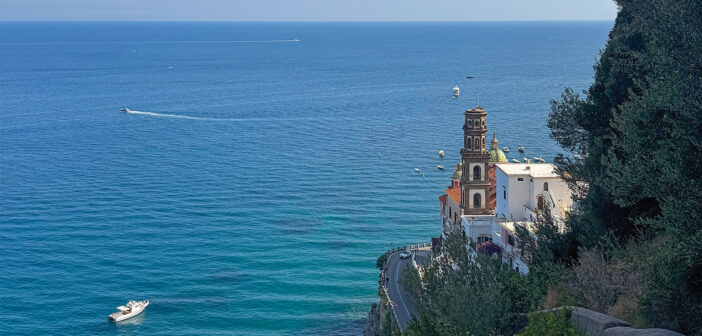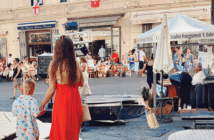Perched high above the Amalfi Coast, Ravello is a hilltop jewel – without a beach, a little harder to reach than its seaside neighbors, and long adored by golden-age movie stars who knew how to escape the crowds.
It feels enchanted, as if it’s been quietly guarding its magic for centuries, waiting for the right kind of visitor to notice.
Two breathtaking villas crown the village: Villa Rufolo and Villa Cimbrone. Villa Rufolo is known for its dreamy classical concerts, often held under the stars – performances that can sweep you away or, judging by the nodding heads I’ve seen mid-sonata, lull you into a blissful nap. Villa Cimbrone, on the other hand, is a spectacle of florals, statues and jaw-dropping views that spill endlessly over the Mediterranean. It’s also home to one of my favorite indulgences: a small outdoor bar serving overpriced champagne and even more overpriced desserts. You don’t go for the value. You go for the view, for the experience. And it’s worth every euro.
The main piazza seems lifted from a postcard: checkered tablecloths on sunlit bistro tables, ceramic studios where artisans shape clay with practiced hands, wine shops offering Campanian reds and whites that beg to be packed in your suitcase.
Whenever I’m on the Amalfi Coast, I carve out a day for Ravello. It’s beautiful. It’s special. And yes – it’s just a little bit fancy.
We’ve always arrived in Ravello on foot from the seaside village of Atrani. The route – 1,770 Roman steps under the baking sun – takes about two hours to travel. Picturesque in theory, the steps are crumbling in places and lose their novelty almost immediately. We’d arrive at the top sweaty and weary – only to undo all that effort with prosecco, cocktails, pizza and pasta. The walk down was easier, but still punishing; different muscles, same shaky legs.
On my last two visits, I made that climb (and descent) while carrying a baby or toddler. No carrier – just bone-deep maternal determination. It was part workout, part pilgrimage, part stubborn tradition.
But this past July, my son was seven. Too big to carry. Too heavy to hoist on a hip. And absolutely unsuited to being hauled down steps that may have been laid before Christ was born. A crisis of tradition loomed: skip the walk entirely? Take the bus like an ordinary tourist? The idea made me recoil.
In the end, we compromised: bus up, walk down. And this time, the little one would do it himself.
After a perfect day – Cimbrone’s gardens, a leisurely lunch and a ceramic purchase or two (which, like toddlers, demand to be carried) – we found the path. It’s easy to miss, marked only by a hand-painted sign reading “Amalfi” with an arrow.
And then, the view opens: lemon groves tumbling down the hillside, the sea glittering far below, the air thick with the scent of citrus and salt.
The path is quiet, almost deserted. You pass iron gates guarding private homes, where dogs poke their noses through the bars in search of a friendly hand. Baskets of lemons are left out for sale, running on the honor system. And all the while, the landscape reminds you: this is a route walked for centuries, changed only by the slow crumble of stone beneath your feet.
As for the little guy? He was a champion.
We took more water breaks than usual, moved at a pace that would lose a race to a determined snail, and I kept one small, sweaty hand in mine the whole way. Step by step, he made it. When we reached the bottom, we were tired, sore and victorious.
We indulged a little less, walked a little slower, but saw more – through his eyes. Watching him beam with pride after finishing something hard, walking a path used for thousands of years reminded me that travel isn’t really about celebrity hideaways or champagne flutes.
It’s about walking in someone else’s footsteps, in another place, in another time – and knowing that your own small footprints now belong to that same story.















